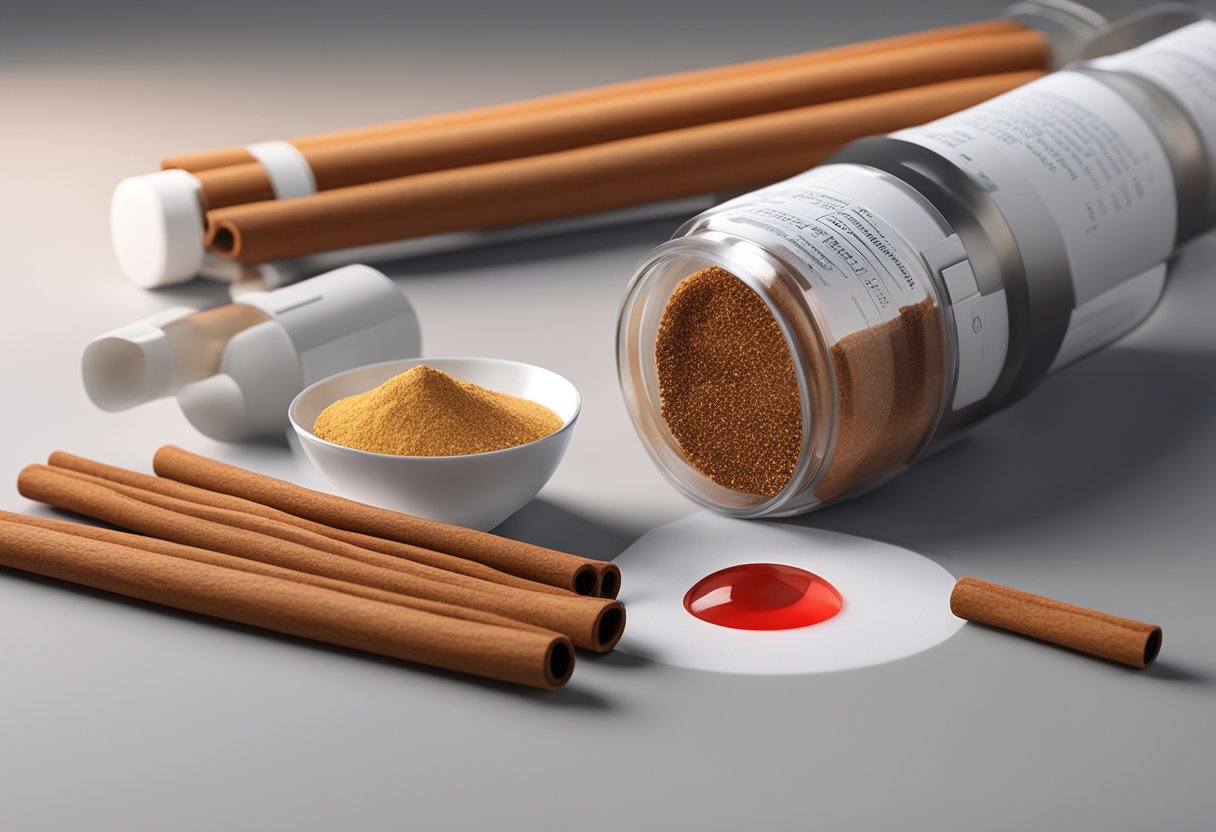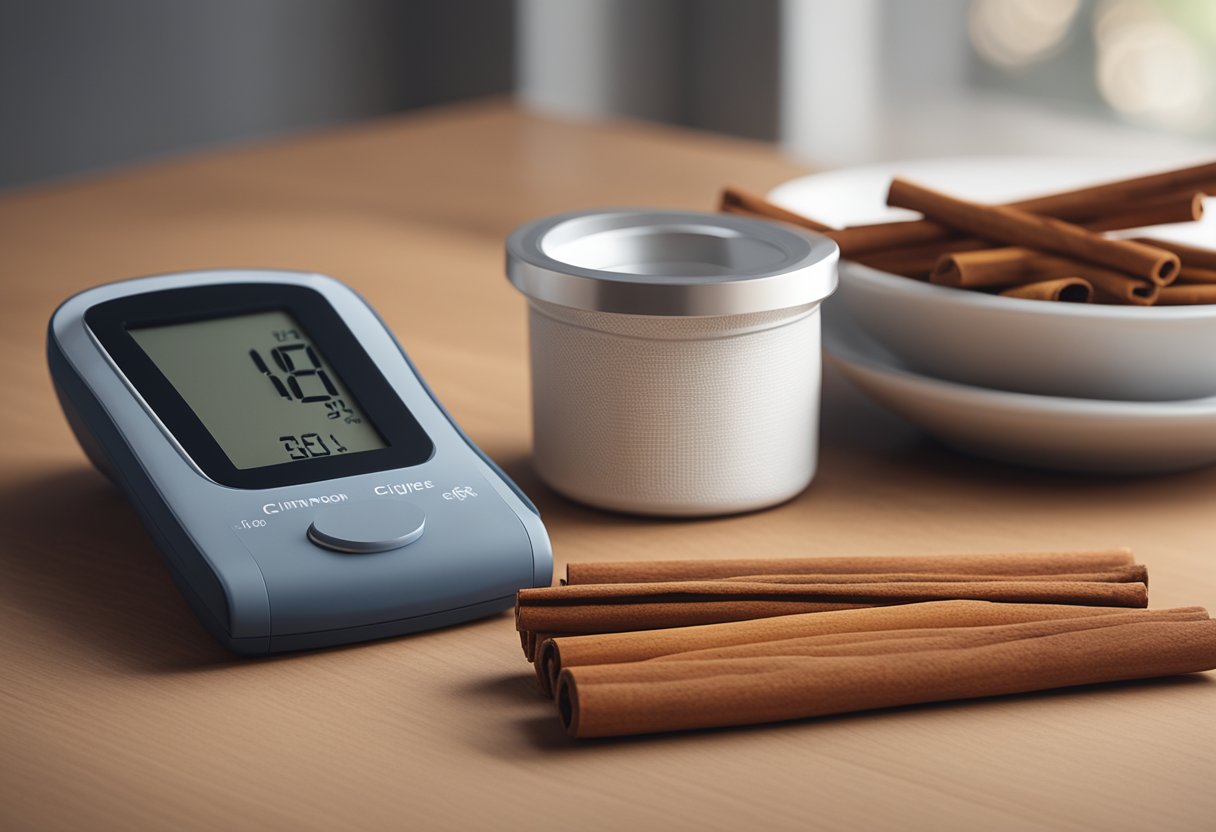Cinnamon is a popular spice that has been used for centuries for its medicinal properties, and emerging research suggests it may offer benefits for managing diabetes[1]. Diabetes is a chronic metabolic condition affecting over 537 million adults worldwide, characterized by elevated blood sugar levels due to the body’s inability to produce sufficient insulin or use it effectively.

Current research indicates that cinnamon supplementation may modestly lower fasting blood glucose levels and improve insulin sensitivity, though effects vary significantly between individuals and studies. Clinical trials have demonstrated that consuming 1-6 grams of cinnamon daily can reduce fasting blood glucose by 16-52 mg/dL and hemoglobin A1c (HbA1c) by 0.27-0.83% in individuals with type 2 diabetes or prediabetes. These improvements, while statistically significant in many studies, are generally modest compared to standard diabetes medications.
Cinnamon contains multiple bioactive compounds[2]—including cinnamaldehyde, proanthocyanidins, and polyphenols—that work through several mechanisms to influence glucose metabolism. These compounds enhance insulin receptor sensitivity, promote glucose transporter (GLUT4) translocation to cell membranes, and activate the AMPK signaling pathway, which plays a crucial role in cellular energy regulation.
However, not all cinnamon is created equal. Ceylon cinnamon (Cinnamomum verum) and Cassia cinnamon (Cinnamomum cassia) differ significantly in their chemical composition, safety profiles, and therapeutic effects. Understanding these differences is essential for anyone considering cinnamon as part of their diabetes management strategy.
It’s important to emphasize that cinnamon should never replace prescribed diabetes medications or lifestyle modifications. Rather, it may serve as a complementary approach when used under medical supervision.
Key Takeaways
-
- Cinnamon may help lower blood sugar levels and improve insulin sensitivity.
-
- Cinnamon contains compounds that mimic the effects of insulin in the body.
-
- Cinnamon may reduce insulin resistance, a major contributing factor to the development of type 2 diabetes.
The Science Behind Cinnamon’s Anti-Diabetic Effects
Molecular Mechanisms of Action
Cinnamon’s ability to influence blood glucose levels involves multiple, interconnected pathways at the cellular and molecular level.
AMPK Signaling Pathway Activation: One of cinnamon’s primary mechanisms involves activating AMP-activated protein kinase (AMPK), often called the body’s “metabolic master switch”. Cinnamon extract stimulates the LKB1-AMPK signaling cascade in both adipose tissue and skeletal muscle cells. When AMPK is activated through phosphorylation of its Thr172 residue, it triggers a cascade of events that increase glucose uptake independent of insulin. This insulin-independent pathway is particularly valuable for individuals with insulin resistance, as it provides an alternative mechanism for cells to absorb glucose from the bloodstream.
Research using 3T3-L1 adipocytes demonstrated that cinnamon extract stimulates glucose uptake in a concentration- and time-dependent manner by activating AMPK, and this effect was completely blocked when AMPK inhibitors were used. This confirms that AMPK activation is essential to cinnamon’s glucose-lowering effects.
Insulin Receptor Enhancement: Cinnamon contains proanthocyanidins—particularly cinnamtannin B1 extracted from Ceylon cinnamon—that directly enhance insulin receptor function. These compounds facilitate phosphorylation of the insulin receptor’s β-subunit, increasing the receptor’s sensitivity to insulin. When insulin binds to its receptor, it triggers autophosphorylation of tyrosine residues, initiating a signaling cascade. Cinnamon extract enhances this process by increasing insulin receptor-β (IRβ) phosphorylation, insulin receptor substrate-1 (IRS1) tyrosine phosphorylation, and the association of IRS1 with phosphoinositide 3-kinase (PI3K).
The methyl hydroxy chalcone polymer in cinnamon activates the insulin receptor-kinase enzyme while simultaneously inhibiting insulin-receptor phosphatase enzyme activity. This dual action maximizes insulin receptor sensitivity and reduces insulin resistance in adipocytes.
GLUT4 Translocation and Expression: Glucose transporter 4 (GLUT4) is the primary insulin-responsive glucose transporter in skeletal muscle and adipose tissue. In diabetes, GLUT4 expression and translocation to the cell membrane are impaired. Cinnamon extract significantly upregulates both GLUT4 gene expression and protein levels, and promotes translocation of existing GLUT4 from intracellular compartments to the plasma membrane.
Studies using C2C12 skeletal muscle cells treated with cinnamaldehyde showed upregulation of GLUT4 receptor mRNA expression through real-time PCR analysis. Cinnamomum zeylanicum extracts specifically enhance GLUT4 translocation and production in the plasma membrane of adipose tissue. This increased GLUT4 availability allows cells to absorb more glucose from the blood, thereby lowering blood sugar levels.
Enzyme Inhibition: Cinnamon also influences digestive enzymes that break down carbohydrates. Aqueous extracts of both C. verum and C. cassia demonstrate anti-α-amylase and anti-α-glucosidase activity. By inhibiting these enzymes, cinnamon slows the breakdown of complex carbohydrates into simple sugars, reducing the rate at which glucose enters the bloodstream after meals. This mechanism is similar to prescription medications like acarbose, though cinnamon’s effect is milder.
PPARs Activation: Cinnamon enhances expression of peroxisome proliferator-activated receptors (PPARs), particularly PPARα and PPARγ, which are nuclear hormone receptors that regulate lipid and glucose metabolism. Activation of PPARγ enhances insulin sensitivity and produces antidiabetic effects, while PPARα activation elevates HDL cholesterol and lowers triglycerides. In mouse adipose tissue, cinnamon extract induces both PPARα and PPARγ expression both in vitro and in vivo, contributing to improved metabolic function.
Reduction of Retinol Binding Protein 4 (RBP4): Elevated serum levels of RBP4 are associated with insulin resistance in both rodents and humans. RBP4 affects glucose production in the liver and mediates insulin resistance in muscle tissue. Importantly, serum RBP4 levels are inversely correlated with GLUT4 expression in adipose tissue. Cinnamon extract, particularly cinnamaldehyde, decreases serum RBP4 levels while enhancing GLUT4 protein expression, creating a favorable metabolic environment for glucose uptake.
Bioactive Compounds and Their Roles
Cinnamaldehyde: This aromatic aldehyde comprises the primary active compound in cinnamon, responsible for its characteristic flavor and aroma. Cinnamaldehyde is 100% bioaccessible in both fasted and fed states, meaning it is fully absorbed regardless of food intake. Once absorbed, it is rapidly converted to cinnamic acid. Cinnamaldehyde upregulates GLUT4 mRNA expression in skeletal muscle cells and enhances protein expression of phosphorylated Akt (p-Akt), suggesting it regulates GLUT4 stimulation and translocation.
Proanthocyanidins (PACs): These polyphenolic compounds comprise at least 15% of standardized cinnamon extracts used in clinical trials. PACs are emerging as key components in modulating glucose homeostasis, and higher PAC intake has been associated with reduced diabetes risk. Research by Jiao et al. found that PACs are the major anti-amyloidogenic compounds in cinnamon water extract, inhibiting the formation of human islet amyloid polypeptide (hIAPP) in a dose-dependent manner. Since hIAPP amyloid formation contributes to pancreatic β-cell dysfunction in type 2 diabetes, PACs may help preserve insulin-producing cells.
Chlorogenic Acids: These polyphenolic compounds enhance insulin signaling and glucose metabolism. Approximately 33% of ingested chlorogenic acid is absorbed in the small intestine, while the remainder reaches the colon, where gut bacteria metabolize it into beneficial compounds.
Cinnamic Acid: A metabolite of cinnamaldehyde, cinnamic acid activates xenobiotic receptors such as PXR (pregnane X receptor) and AhR (aryl hydrocarbon receptor), which regulate liver enzyme production. While this activation plays a role in drug metabolism, cinnamic acid also contributes to cinnamon’s antioxidant and anti-inflammatory effects.

Cinnamon’s Role in Diabetes Management

Cinnamon Types and Forms

Cinnamon is a spice that has been used for centuries in traditional medicine to treat various ailments. It is available in different types and forms, each with its unique properties and benefits.
Ceylon vs. Cassia – Critical Safety Differences
The distinction between Ceylon and Cassia cinnamon is not merely botanical—it has profound implications for safety, particularly for individuals considering long-term supplementation.
Coumarin Content: The Safety Divide
Cassia Cinnamon (Cinnamomum cassia, C. burmannii, C. loureiroi): Cassia varieties contain approximately 1% coumarin by weight, or 2,650-7,017 mg/kg depending on the specific variety. Indonesian cinnamon (C. burmannii) and Saigon cinnamon (C. loureiroi) actually contain even more coumarin than standard Cassia. An average teaspoon of Cassia cinnamon (approximately 2.6 grams) contains 6.9-18 mg of coumarin.
Ceylon Cinnamon (Cinnamomum verum or C. zeylanicum): In stark contrast, Ceylon cinnamon contains only 0.004% coumarin—approximately 250 times less than Cassia. This coumarin content is often so low that it’s undetectable in laboratory testing.
Health Implications of Coumarin
Coumarin is a naturally occurring compound that can cause liver damage, kidney damage, and lung toxicity in high doses. The European Food Safety Authority (EFSA) and German health authorities have established a tolerable daily intake (TDI) of coumarin at 0.1 mg per kg of body weight (reduced from the previous 0.5 mg/kg).
For context: A 70 kg (154 lb) adult has a TDI of 7 mg of coumarin daily. Just one teaspoon of Cassia cinnamon can contain 6.9-18 mg of coumarin—easily exceeding or approaching the daily safety limit. For a 18 kg (40 lb) child, the TDI is only 1.8 mg, which could be found in a small portion of a cinnamon-flavored baked good.
Regular consumption of Cassia cinnamon beyond these limits has been associated with liver damage in case reports. Individuals with pre-existing liver disease are at particularly high risk.
Anticoagulant Risk
Coumarin has blood-thinning (anticoagulant) properties. For individuals taking blood-thinning medications such as warfarin, apixaban, or aspirin, consuming large amounts of Cassia cinnamon could potentiate anticoagulant effects and increase bleeding risk. This interaction is especially concerning because it may not be obvious until a bleeding event occurs.
Which Should You Choose?
For daily or long-term use: Ceylon cinnamon is the clear choice due to its negligible coumarin content. It is significantly safer for individuals who consume cinnamon regularly or in larger amounts for therapeutic purposes.
For occasional culinary use: Small amounts of Cassia cinnamon used occasionally in cooking are generally safe for most people.
Identification: Check product labels carefully. Authentic Ceylon cinnamon will be labeled “Ceylon,” “True Cinnamon,” or “Cinnamomum verum” or “C. zeylanicum“. If the label simply says “cinnamon” without specifying the variety, it is almost certainly Cassia, as this is the cheaper and more commonly sold variety in North America.
Physical characteristics: Ceylon cinnamon sticks are composed of multiple thin layers that easily crumble, and create a fine, light tan powder. Cassia sticks are harder, thicker, form a single roll, and produce a coarser, reddish-brown powder.
Clinical Research

Recent High-Quality Studies
Prediabetes Intervention (2024): A 4-week randomized, double-blind crossover trial published in the American Journal of Clinical Nutrition evaluated the effects of cinnamon on continuously monitored glycemic response in adults with prediabetes. This study used continuous glucose monitoring to assess real-time blood sugar changes throughout the day—a more comprehensive approach than traditional fasting glucose measurements. While specific numeric outcomes were not fully detailed in available abstracts, the study represents cutting-edge methodology for assessing cinnamon’s glycemic effects[3].
Berberine-Cinnamon Combination (2025): A 12-week randomized, double-blind, placebo-controlled trial investigated the combined effects of berberine (1200 mg/day) and cinnamon (600 mg/day) in patients with type 2 diabetes. Results showed significant reductions in fasting blood sugar[4] (p=0.031), HbA1c (p=0.013), and LDL cholesterol (p=0.039) compared to placebo. This combination therapy may offer synergistic benefits beyond either compound alone.
Ceylon Cinnamon Meta-Analysis (2025): Research specifically on Cinnamomum zeylanicum (Ceylon cinnamon) demonstrated improvements in fasting blood glucose and HbA1c[5] through activation of the AMPK signaling pathway and enhancement of GLUT4 translocation. The study confirmed that proanthocyanidins comprising 15% of the extract are key components responsible for glucose-lowering effects.
Anthropometric Effects Trial (2025): A triple-blind, placebo-controlled trial with 140 participants consuming 3g/day of encapsulated Ceylon cinnamon for 90 days found reductions in weight, BMI, waist circumference, and other measurements, though these did not reach statistical significance (p>0.05). This suggests cinnamon’s primary benefits lie in glycemic control rather than weight loss[6].
Systematic Reviews and Meta-Analyses
2013 Annals of Family Medicine Meta-Analysis[7]: This comprehensive systematic review analyzed 10 randomized controlled trials with 543 patients with type 2 diabetes. Key findings included:
-
Capsule forms of cinnamon significantly reduced HbA1c by 0.27% (95% CI: -0.54% to -0.01%) and fasting glucose by 16.74 mg/dL (95% CI: -25.44 to -8.05 mg/dL)
-
Powder forms showed no significant benefit for either HbA1c or fasting glucose
-
Dosages ranged from 120 mg to 6 grams daily, with study durations of 4-16 weeks
2019 Meta-Analysis on HbA1c Effects: Multiple studies examining the effect of 1-6 grams of cinnamon daily found varying degrees of HbA1c reduction[8]. One study reported a 0.83% decrease in HbA1c in the cinnamon group compared to 0.37% in controls over 90 days. Another found that 1.5 grams daily for 12 weeks resulted in significant improvements in preprandial blood glucose and HbA1c (p<0.05).
2022 Prediabetes Study: A 10-week pilot study[9] with 52 prediabetic subjects receiving 1000 mg/day of cinnamon supplements found no statistically significant differences in HbA1c, BMI, or body fat percentage compared to controls. The authors suggested that longer study durations may be necessary to detect HbA1c changes, as this marker reflects 2-3 months of average blood glucose.
Limitations and Conflicting Results
Despite promising findings, research on cinnamon remains inconsistent. The 2016 systematic review by the NIH Office of Dietary Supplements evaluated 11 randomized controlled trials and concluded that while all studies reported some reductions in fasting plasma glucose with cinnamon, only four achieved American Diabetes Association treatment goals (fasting glucose <130 mg/dL or HbA1c <7.0%).
Heterogeneity between studies—including differences in cinnamon species, dosage forms (powder vs. extract vs. capsules), doses (ranging from 120 mg to 6 grams daily), study duration, and baseline patient characteristics—makes it difficult to draw definitive conclusions. Mayo Clinic experts note that “despite many studies, it isn’t clear whether cinnamon helps lower blood sugar in people with diabetes”.
Health Benefits Beyond Diabetes

Cinnamon has been used for centuries in traditional medicine to treat a variety of ailments. In addition to its potential benefits for managing diabetes, cinnamon has been shown to have other health benefits as well.
Cholesterol and Lipid Levels
Cinnamon may help improve cholesterol and lipid levels in the body. A study published in the Journal of Medicinal Food found that cinnamon supplementation resulted in a significant decrease in total cholesterol, triglycerides, and low-density lipoprotein cholesterol (LDL-C) levels, as well as an increase in high-density lipoprotein cholesterol (HDL-C) levels in people with type 2 diabetes.
Antioxidants and Inflammation
Cinnamon is also a rich source of antioxidants, which help protect the body against oxidative stress and inflammation. A review published in the journal Nutrients found that cinnamon has been shown to have anti-inflammatory and antioxidant effects in both animal and human studies. These effects may help protect against chronic diseases such as cardiovascular disease, cancer, and neurodegenerative diseases.
Cardiovascular Health
Cinnamon may also have beneficial effects on cardiovascular health. A study published in the journal Diabetes Care found that cinnamon supplementation resulted in a significant reduction in blood pressure in people with type 2 diabetes. Additionally, a review published in the journal Nutrition Today found that cinnamon may help improve endothelial function, which is an important factor in maintaining healthy blood vessels.
Overall, while cinnamon is often touted for its potential benefits in managing diabetes, research suggests that it may have other health benefits as well. Cinnamon may help improve cholesterol and lipid levels, have antioxidant and anti-inflammatory effects, and improve cardiovascular health. However, more research is needed to fully understand the extent of these potential benefits.
Interactions with Medications and Diet

Cinnamon, when taken as a supplement, may interact with certain medications and dietary components. Understanding these interactions is important to avoid any negative effects.
Diabetes Medications
Cinnamon may interact with diabetes medications, including insulin and oral hypoglycemic agents. It may potentiate the effects of these medications, leading to hypoglycemia. Therefore, it is important for individuals taking diabetes medications to monitor their blood sugar levels regularly and consult with their healthcare provider before taking cinnamon supplements.
Herbs and Supplements
Cinnamon supplements may interact with other herbs and supplements that affect blood sugar levels. For example, taking cinnamon supplements along with other blood sugar-lowering supplements such as fenugreek, ginseng, or bitter melon may lead to hypoglycemia. Therefore, it is important to consult with a healthcare provider before taking cinnamon supplements along with other herbs and supplements.
Dietary Considerations
Dietary components such as sugars and carbohydrates may also interact with cinnamon supplements. Consuming high amounts of sugars and carbohydrates while taking cinnamon supplements may lead to an increase in blood sugar levels. Therefore, individuals with diabetes should monitor their sugar and carbohydrate intake while taking cinnamon supplements.
It is important to note that cinnamon supplements are not a substitute for diabetes medications or a healthy diet. Individuals with diabetes should continue to follow their prescribed treatment plan and consult with their healthcare provider before taking any supplements.
Safety and Side Effects

Cinnamon has been used as a natural remedy for various ailments, including diabetes, for centuries. While it is generally considered safe for consumption, there are some potential side effects and precautions to consider.
Liver Damage and Toxicity
Cinnamon contains a compound called coumarin, which can cause liver damage and toxicity when consumed in large amounts. According to a systematic review and meta-analysis, high doses of cinnamon supplements (more than 5 grams per day) can cause liver damage and increase the risk of toxicity. However, the review also found that lower doses of cinnamon (less than 5 grams per day) did not cause any significant harm to the liver.
To avoid the risk of liver damage and toxicity, it is recommended to consume cinnamon in moderate amounts. One teaspoon of cinnamon powder (about 2.6 grams) per day is considered a safe and effective dose for managing blood sugar levels in people with type 2 diabetes.
Dosage and Precautions
In addition to liver damage and toxicity, cinnamon can also interact with certain medications and cause allergic reactions in some people. Therefore, it is important to take precautions and consult a healthcare professional before consuming cinnamon supplements or using cinnamon as a natural remedy for diabetes.
Here are some dosage and precautionary measures to consider:
-
- Use Ceylon cinnamon (also known as “true” cinnamon) instead of cassia cinnamon, which contains higher levels of coumarin.
-
- Limit the intake of cinnamon supplements to less than 5 grams per day.
-
- Monitor blood sugar levels regularly when consuming cinnamon supplements.
-
- Avoid consuming cinnamon supplements if you are taking medications that can interact with cinnamon, such as blood thinners, diabetes medications, and antibiotics.
-
- Consult a healthcare professional before using cinnamon as a natural remedy for diabetes, especially if you have liver disease, kidney disease, or are pregnant or breastfeeding.
Overall, cinnamon can be a safe and effective natural remedy for managing blood sugar levels in people with type 2 diabetes. However, it is important to take precautions and consume cinnamon in moderate amounts to avoid potential side effects and interactions with medications.
Recommendations and Usage

Incorporating Cinnamon into Diet
Cinnamon is a versatile spice that can be incorporated into a variety of dishes. One popular way to consume cinnamon is by adding it to oatmeal or yogurt. Cinnamon can also be used in baking, such as in cinnamon rolls or apple pie. However, it is important to note that consuming large amounts of cinnamon may have negative health effects. The recommended daily intake of cinnamon is 1-6 grams per day, which is equivalent to about 0.5-2 teaspoons.
American Diabetes Association Guidelines
The American Diabetes Association (ADA) recommends that people with diabetes consume a healthy diet that is low in saturated and trans fats, and high in fiber. Cinnamon can be a useful addition to a healthy diet for people with diabetes. However, the ADA does not currently recommend the use of cinnamon supplements for the treatment of diabetes, as there is not enough evidence to support their effectiveness.
In addition to a healthy diet, exercise is also important for people with diabetes. Regular physical activity can help improve blood sugar control and reduce the risk of complications. The ADA recommends that people with diabetes engage in at least 150 minutes of moderate-intensity aerobic exercise per week, spread out over at least three days per week.
Overall, incorporating cinnamon into a healthy diet can be a beneficial way to help manage blood sugar levels in people with diabetes. However, it is important to consult with a healthcare provider before making any significant changes to diet or exercise routines.
Potential Complications of Diabetes

Frequently Asked Questions
How much cinnamon should I take daily for diabetes?
Clinical trials[7] have used doses ranging from 1-6 grams daily, with 1.5-3 grams appearing most commonly effective. However, there is no universally established optimal dose. Start with 1 gram daily (approximately 1/2 teaspoon) and monitor your blood glucose response. Choose Ceylon cinnamon for regular use to minimize coumarin exposure, especially if consuming more than 2 grams daily. Always consult your healthcare provider before starting supplementation.
How quickly will I see results from taking cinnamon?
Effects on fasting blood glucose may be noticeable within 2-4 weeks[10] of consistent use, but HbA1c changes—which reflect longer-term glucose control—typically require 8-12 weeks (2-3 months) to become apparent. Some individuals may experience minimal or no benefit. Keep detailed blood glucose logs to track your individual response.
Is Ceylon or Cassia cinnamon better for diabetes?
Both types show glucose-lowering effects in research[11], but Ceylon cinnamon is strongly preferred for daily or therapeutic use due to its minimal coumarin content (250 times less than Cassia). Ceylon provides similar benefits without the liver toxicity risk associated with long-term, high-dose Cassia consumption. If using Cassia, limit intake to 1-2 grams daily.
Can I take cinnamon if I’m already on diabetes medications?
You can, but only under medical supervision[12]. Cinnamon’s glucose-lowering effects can add to those of diabetes medications, potentially causing hypoglycemia (dangerously low blood sugar). Monitor blood glucose closely when starting cinnamon, and work with your healthcare provider to adjust medication doses if needed. Never stop or reduce prescribed medications without medical guidance.
What are the main side effects of cinnamon supplementation?
When consumed in recommended amounts, cinnamon is generally well-tolerated. Potential side effects include:
-
Allergic reactions: mouth sores, burning sensation, skin rash (rare)
-
Liver damage: only with chronic high-dose Cassia cinnamon due to coumarin content
-
Gastrointestinal issues: heartburn, nausea, diarrhea at high doses
-
Hypoglycemia: when combined with diabetes medications
-
Drug interactions: particularly with blood thinners and liver-metabolized medications
Choose Ceylon cinnamon and stay within recommended doses[13] (1-6 grams daily) to minimize risk.
Can cinnamon cure or reverse type 2 diabetes?
No, cinnamon cannot cure or reverse diabetes. While it may help modestly lower blood glucose and improve insulin sensitivity, its effects are significantly smaller than standard diabetes medications. Cinnamon should be viewed as a complementary approach[14] that may enhance—but never replace—evidence-based diabetes treatments including medications, dietary modifications, exercise, and weight management.
Are cinnamon supplements better than using cinnamon powder in food?
Meta-analysis data suggests that capsule or standardized extract forms may be more effective than powder forms, possibly due to better absorption or more consistent bioactive compound content. However, using cinnamon powder in food is still beneficial and carries lower risk of excessive intake. Supplements provide precise dosing but require more caution regarding interactions and side effects.
Should people with prediabetes take cinnamon?
Some research suggests cinnamon may be beneficial for individuals with prediabetes by helping to stabilize blood glucose and potentially preventing progression to type 2 diabetes. A 2024 study using continuous glucose monitoring in prediabetic adults evaluated this effect, and a 2022 study found that while cinnamon supplementation didn’t significantly change HbA1c in 10 weeks, it may prevent progressive increases in glucose metrics. Consult your healthcare provider to determine if cinnamon supplementation makes sense as part of your prediabetes management plan.
References
- Efficacy of cinnamon in reducing anthropometric measurements in individuals with type 2 diabetes: a clinical trial. https://pmc.ncbi.nlm.nih.gov/articles/PMC12252926/ Accessed November 4, 2025
- Cinnamon extract improves abnormalities in glucose tolerance by decreasing Acyl-CoA synthetase long-chain family 1 expression in adipocytes. https://www.nature.com/articles/s41598-022-13421-9 Accessed November 4, 2025
- ScienceDirect. https://www.sciencedirect.com/science/article/pii/S000291652400008X Accessed November 4, 2025
- The efficacy and safety of berberine in combination with cinnamon supplementation in patients with type 2 diabetes: a randomized clinical trial. https://pubmed.ncbi.nlm.nih.gov/39998703/ Accessed November 4, 2025
- Effects of Cinnamomum zeylanicum (Ceylon cinnamon) extract on lipid profile, glucose levels and its safety in adults: A randomized, double-blind, c.... https://journals.plos.org/plosone/article?id=10.1371%2Fjournal.pone.0317904 Accessed November 4, 2025
- rather than weight loss. Accessed November 4, 2025
- Cinnamon Use in Type 2 Diabetes: An Updated Systematic Review and Meta-Analysis. https://pmc.ncbi.nlm.nih.gov/articles/PMC3767714/ Accessed November 4, 2025
- The Effect of Different Amounts of Cinnamon Consumption on Blood Glucose in Healthy Adult Individuals. https://pmc.ncbi.nlm.nih.gov/articles/PMC6425402/ Accessed November 4, 2025
- Just a moment.... https://www.liebertpub.com/doi/10.1089/imr.2021.0018 Accessed November 4, 2025
- Cinnamon for diabetes. https://www.pharmacist.com/Blogs/CEO-Blog/cinnamon-for-diabetes Accessed November 4, 2025
- ScienceDirect. https://www.sciencedirect.com/science/article/abs/pii/S2210803320300142 Accessed November 4, 2025
- Diabetes treatment: Can cinnamon lower blood sugar?. https://www.mayoclinic.org/diseases-conditions/diabetes/expert-answers/diabetes/faq-20058472 Accessed November 4, 2025
- What is the recommended dosage of cinnamon for managing blood sugar levels?. https://ubiehealth.com/doctors-note/cinnamon-blood-sugar-dosage Accessed November 4, 2025
- Do Cinnamon Supplements Have a Role in Glycemic Control in Type 2 Diabetes – A Narrative Review?. https://pmc.ncbi.nlm.nih.gov/articles/PMC5085873/ Accessed November 4, 2025
